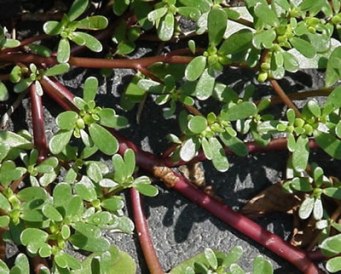Purslane is commonly known as Pigweed, Verdolaga, Pusley, or Little Hogweed and is a very delicious edible weed that is probably growing in your yard right now.
Purslane grows everywhere. Purslane likes heat and usually grows best during July and August and can be eaten raw in salads, sauted with onions and garlic, or blanched and served with a little olive oil, salt and pepper.
Purslane contains high amounts of mega-3 fatty acid generally found in vegetables, as well as small amounts of EPA and DHA, omega-3 fatty acids more commonly found in fish. This essential fatty acid plays a key role in maintaining heart health. Purslane is also high in vitamins A, C and E, which are known for their antioxidant powers. This edible weed also contains two Beta Pigments, beta-cyanins and beta-xanthins, which act as antioxidants.
Vitamins and minerals: Purslane is low in calories and fat, but this weed does contain high amounts of dietary minerals such as iron, magnesium, calcium, potassium and manganese.
Substitute Purslane for other leafy green vegetables in your cooking or use it to garnish sandwiches, add it to soups and stews, and incorporate it into your salads. If you’re pregnant, avoid purslane as it can make the uterine muscles contract. Purslane has a slightly pepper flavor and can be tart at times.
How do you identify purslane?
Purslane grows out from one main taproot, sprawling out in all directions. The stem ranges from green to pink to red, and sometimes can be brown in color. The stem can be quite thick- as wide as a finger towards the middle of the rosette, and tapers down to a thin stem at the outside. There often are thinner stems branching off of each larger stem. Along the stems at regular intervals are thick, fleshy, rounded teardrop shaped leaves. The top of the leaves are a shiny, dark green, while the underside is a more matted light grey green color. Purslane has small yellow flowers that only open up in the morning.
There is a plant that looks similar to Purslane that is poisonous. The poisonous plant is known as Spurge. The stems of Spurge are much thinner than Purslane stems, and spurge leaves are thin, unlike purslane’s thick, succulent leaves.
Spurge is poisonous, and you don’t want to be eating it, but fortunately it’s easy to tell Spurge from Purslane. When you break the stem of a Spurge plant a white, milky sap will leak out of it. When you break the stem of a Purslane plant you do not get this milky substance.
The following picture is of a Spurge Plant.
ALWAYS MAKE SURE THAT YOU HAVE IDENTIFIED ANY PLANT AS SAFE TO EAT BEFORE EATING IT!




I keep pulling this out of my planting beds, and I had no idea that it was edible. Thanks for this post!
If you get some Purslane, I would like to have you share your recipe with me so I may put it on this blog. Thanks.
Me too!!! Who would have thought you could eat something you’ve been fighting for years? Now watch, this summer, it won’t show up!